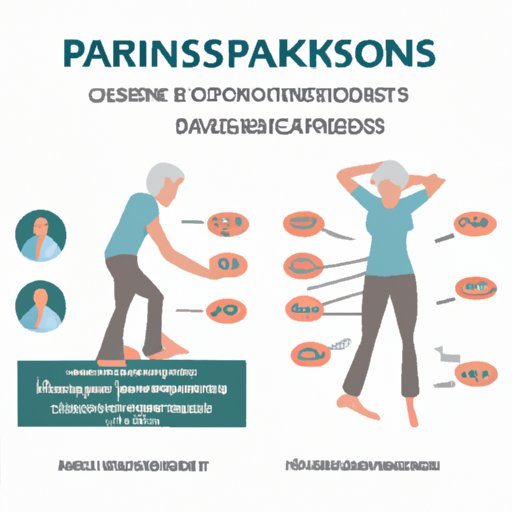
Understanding Parkinsonian Symptoms: Signs, Science, and Coping Strategies
Parkinson’s disease is a progressive neurological disorder that affects millions of people worldwide. Characterized by a range of symptoms, Parkinson’s is a condition that affects a person’s ability to control movement and can have a significant impact on one’s quality of life. In this article, we’ll explore Parkinsonian symptoms in-depth, from tremors to loss of automatic movements.
Identifying Parkinsonian Symptoms: Signs to Look Out For
While Parkinson’s disease affects each person differently, there are some common symptoms that point to the condition. Here are some of the key signs to look out for:
Tremors and Shaking
One of the most recognizable Parkinsonian symptoms is tremors, where a person’s hands, feet, or head may shake involuntarily. Tremors can also occur during rest and increase with stress or excitement.
Rigidity and Stiffness
A person with Parkinson’s disease may experience muscle rigidity, which makes movements difficult or painful. Stiffness can occur in any part of the body, from the limbs to the neck and shoulders.
Bradykinesia (a.k.a. Slow Movements)
Slower movements are another sign of Parkinson’s disease. A person may have difficulty initiating movements, such as getting up from a sitting position, and may take longer to complete actions like walking or turning.
Changes in Posture and Balance
As Parkinson’s disease progresses, a person may develop a stooped posture, a shuffle in their walk, or balancing issues. They may be more prone to falls and have difficulty recovering from them.
Loss of Automatic Movements
Another symptom of Parkinson’s disease is the loss of automatic movements, such as blinking, smiling, or swinging the arms when walking. A person may also have difficulty with tasks that require fine motor skills, like writing or buttoning a shirt.
Dystonia and Freezing
Dystonia refers to muscle contractions that cause twisting and abnormal postures, often occurring in the hands or feet. Freezing is when a person feels “stuck” in their movements, unable to initiate or complete an action.
The Science behind Parkinsonian Symptoms: Exploring the Neurological Basis
Understanding the underlying cause of Parkinson’s disease can help us better understand its symptoms. Parkinson’s disease is caused by the death of dopamine-releasing cells in the brain, which affects the transmission of signals to the muscles that control movement.
Explanation of How Dopamine Works
Dopamine is a neurotransmitter that communicates with the basal ganglia, a group of brain structures responsible for motor control. When dopamine levels are low, the basal ganglia can’t function correctly, leading to Parkinsonian symptoms.
The Role of the Basal Ganglia in Parkinson’s Disease
The basal ganglia are vital for controlling movement. Parkinson’s disease affects the substantia nigra, the part of the basal ganglia responsible for dopamine production. It leads to a decrease in dopamine levels, leading to the symptoms of Parkinson’s disease.
Overview of Lewy Bodies
Lewy bodies are abnormal protein deposits that are found in nerve cells in the brain of people with Parkinson’s disease. These protein deposits cause damage and death in cells that produce dopamine, leading to Parkinson’s disease symptoms.
Parkinson’s Disease and Parkinsonian Symptoms: What You Need to Know
People with Parkinson’s disease have a variety of symptoms, but not everyone will experience every symptom. Here are some essential facts to understand about Parkinson’s disease:
What is Parkinson’s Disease?
Parkinson’s disease is a chronic and progressive neurodegenerative disorder that affects the central nervous system. It gets worse over time and affects a person’s ability to control their movements.
How Are Parkinsonian Symptoms Related to Parkinson’s Disease?
Parkinsonian symptoms are the hallmark of Parkinson’s disease and occur when there is a decline in the dopamine levels in certain regions of the brain.
The Possible Causes and Risk Factors of Parkinson’s Disease
The exact cause of Parkinson’s disease is unknown, but some scientists believe a combination of genetic and environmental factors may be at play. Age is a significant factor, with most people developing Parkinson’s disease after the age of 60.
Living with Parkinsonian Symptoms: Coping Strategies and Treatment Options
While there is no cure for Parkinson’s disease, there are treatments and coping strategies available to manage symptoms. Here are some options to consider:
Medications for Treating Parkinsonian Symptoms
Various medications can improve Parkinsonian symptoms, like dopamine replacement therapy, which helps to increase dopamine levels. Some people may also take medications to address non-motor symptoms, like depression or sleep issues.
Surgical Procedures
Surgical procedures, like deep brain stimulation surgery, can help improve motor symptoms in people with Parkinson’s disease. However, surgery is usually reserved for people who don’t respond well to medications.
Non-drug Treatment Options
Non-drug treatment options, such as physical therapy, occupational therapy, and speech therapy, can help improve symptoms and maintain independence. Exercise programs, like yoga or tai chi, may also be beneficial.
Tips for Coping with Parkinson’s Disease
Living with Parkinson’s disease can be challenging, but there are strategies that can help. Getting enough sleep, maintaining a healthy lifestyle, and seeking support through a local Parkinson’s disease organization are some ways to cope.
From Tremors to Frozen Movements: Demystifying Parkinsonian Symptoms
Real-life stories from people with Parkinson’s disease can help us better understand what it’s like to live with Parkinsonian symptoms. Each person’s experience of Parkinson’s is unique, but hearing from others can offer support and encouragement.
Personal Perspectives on Living with Parkinsonian Symptoms
Many people with Parkinson’s disease have overcome tremendous challenges to lead fulfilling lives. Advocacy organizations, like the Parkinson’s Foundation, offer resources and ways to connect with others living with the disease.
Conclusion
Parkinson’s disease is a complex condition that affects each person differently. Seeking professional help, maintaining an open dialogue with healthcare providers, and engaging in physical therapy, medications, or alternative therapies, can help manage Parkinsonian symptoms. Ongoing research may even lead to new treatments and a cure.




